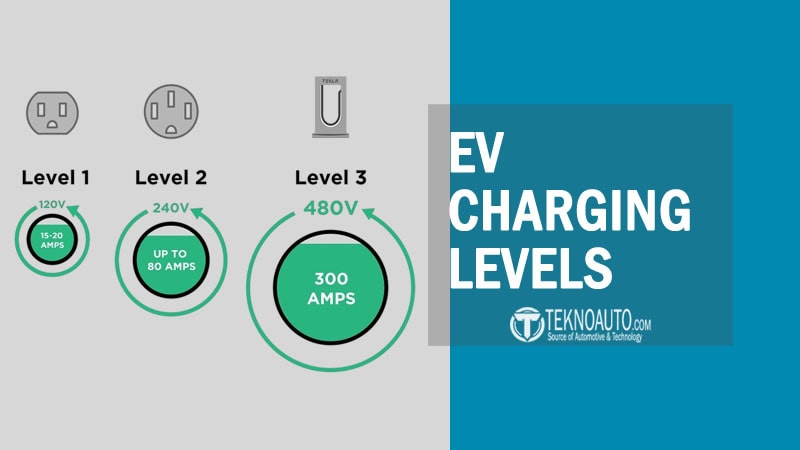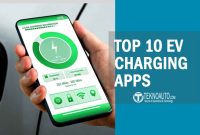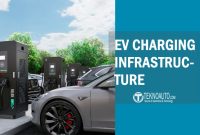Choosing the right electric vehicles (EVs) charger isn’t just a technical detail—it shapes your entire driving experience. From how long your car sits in the driveway to how much you’ll spend on energy each month, the charging level you use plays a key role. And with more drivers switching to electric—from city-friendly plug-in hybrids to full-size SUVs—knowing the difference between EV charging levels is no longer optional.
Understanding the differences between Level 1, Level 2, and Level 3 charging (also known as DC Fast Charging) is essential to making informed decisions—especially as public infrastructure continues to expand and home charging becomes more common. Each charging level delivers electricity at different speeds and voltages, and not every EV is compatible with every charging method.
In this comprehensive guide, we’ll break down what makes each level unique, explore when and where to use them, and help you choose the best charging option for your daily routine, road trips, or commercial needs.
Before we dive into the details of each charging level, let’s first define what EV charging levels actually are—and why they matter.
What Are EV Charging Levels?
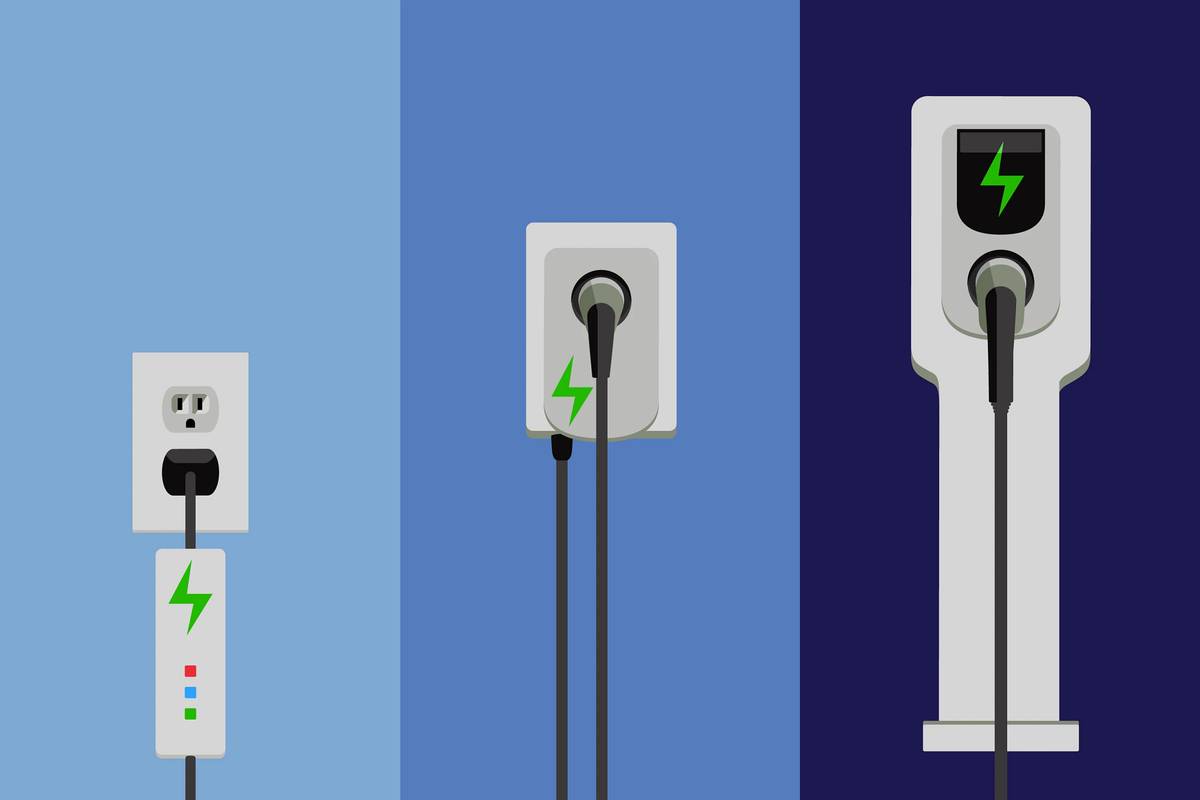
EV charging levels refer to the standardized categories that define how fast electric vehicles can be charged based on the voltage, amperage, and power delivery method. There are three main levels:
- Level 1: Uses a standard household outlet (120 volts)
- Level 2: Uses a higher voltage outlet (240 volts)
- Level 3 (DC Fast Charging): Uses direct current and industrial-grade power for ultra-fast charging
Each level serves a different purpose depending on where you charge (home vs public), how fast you need to charge, and what your vehicle supports.
The Role of Voltage and Power
The higher the voltage and current delivered, the faster your EV can charge. Here’s a breakdown of the relationship:
| Charging Level | Voltage | Typical Power Output | Charging Speed (Range per Hour) | Power Type |
|---|---|---|---|---|
| Level 1 | 120V | 1.3–2.4 kW | 2–5 miles | AC |
| Level 2 | 240V | 3.3–19.2 kW | 10–40 miles | AC |
| Level 3 (DCFC) | 400V–1000V+ | 50–350+ kW | 100–1000+ miles (per hour) | DC |
Why Charging Levels Matter
Choosing the right charging level is not just about speed—it affects:
- Cost per charge
- Battery health over time
- Convenience of access
- Infrastructure requirements
Knowing when to use each level ensures you’re charging efficiently without overspending or stressing your EV’s battery unnecessarily.
Next, let’s explore each charging level in detail—starting with the most basic one: Level 1 EV Charging.
Level 1 EV Charging: Entry-Level Home Charging

Level 1 EV Charging is the most basic form of electric vehicle charging, using a standard 120-volt household outlet—the same one you’d use for a toaster or lamp. It requires no special equipment or installation, making it the most accessible charging method for new EV owners.
While it’s not the fastest option, it does offer a convenient and affordable solution for certain use cases.
How Level 1 Charging Works
All EVs come with a portable Level 1 charging cable that plugs directly into a wall outlet. This cable typically provides:
- 1.3 to 2.4 kilowatts of power
- Charging speeds of 2–5 miles of range per hour
- A full charge in 12 to 30+ hours, depending on battery size
It uses alternating current (AC), and the car’s onboard charger converts this into direct current (DC) to charge the battery.
Who Should Use Level 1 Charging?
Level 1 is ideal for:
- Plug-in hybrid (PHEV) owners with small batteries (e.g., 8–15 kWh)
- Commuters driving short daily distances (under 40 miles)
- EV owners with overnight parking access and plenty of time
For example, if you plug in your EV every night at home, a Level 1 charger can add 30–40 miles by morning—enough for most local trips.
Pros and Cons of Level 1 Charging
| Pros | Cons |
|---|---|
| No installation required | Very slow charging speed |
| Works with any standard outlet | May not keep up with daily driving needs |
| Low or zero upfront cost | Not ideal for large battery EVs |
| Perfect for plug-in hybrids | Long full-charge times (12–30+ hours) |
Installation Requirements and Safety
Level 1 charging needs a grounded 3-prong outlet on a dedicated circuit to avoid overloading the wiring. For long-term use:
- Use outdoor-rated outlets if charging outside
- Avoid using extension cords
- Check for circuit breaker trips or heat buildup at the plug
When to Upgrade from Level 1
If your driving range needs exceed 40 miles per day or if you own a long-range BEV, Level 1 charging may not be practical long-term. In that case, consider installing a Level 2 charger for faster and more flexible home charging.
Level 2 EV Charging: Faster Charging at Home and Public Locations

Level 2 EV charging strikes the ideal balance between speed, affordability, and accessibility. It is the most common charging solution for both residential and public settings, offering a significantly faster alternative to Level 1 while remaining practical for everyday use.
Using a 240-volt power source—similar to what powers an electric dryer or oven—Level 2 chargers can replenish an EV’s battery 4 to 10 times faster than a standard wall outlet.
How Level 2 Charging Works
Level 2 chargers deliver 3.3 to 19.2 kilowatts of alternating current (AC), which is converted by the vehicle’s onboard charger into direct current (DC) to fill the battery.
Charging speeds typically range from 10 to 40 miles of range per hour, depending on:
- The power output of the charger
- The car’s maximum AC charging acceptance rate
- Environmental conditions (especially temperature)
Use Cases for Level 2 Charging
Level 2 is the go-to solution for:
- Homeowners with a long daily commute
- Businesses and offices providing EV charging to employees
- Retail locations and public parking lots
- Apartment complexes offering shared EV infrastructure
Many EV owners install Level 2 chargers in their garage or driveway to ensure their car is fully charged overnight—even with large battery packs.
Level 2 Charger Types and Features
| Feature | Description |
|---|---|
| Power Output | 3.3 kW – 19.2 kW (average residential: 7.2 kW) |
| Connector | SAE J1772 (North America standard), compatible with all EVs |
| Smart Charging Options | Wi-Fi, mobile app control, scheduling, energy monitoring |
| Mounting | Wall-mounted indoor/outdoor units, portable plug-in versions also available |
Popular brands include ChargePoint Home Flex, JuiceBox, Wallbox Pulsar Plus, and Grizzl-E.
Installation and Costs
Installing a Level 2 charger typically requires:
- A 240V outlet or hardwired connection
- A dedicated circuit rated for 30–50 amps
- Professional installation by a licensed electrician
| Cost Component | Price Range |
|---|---|
| Charger Unit | $400 – $1,200 |
| Professional Install | $300 – $1,000+ |
| Total Cost (Average) | $700 – $2,000 |
Rebates and tax credits may be available from local utilities or governments to help offset costs.
Advantages of Level 2 Charging
| Pros | Cons |
|---|---|
| Much faster than Level 1 (up to 10x) | Requires installation and 240V access |
| Ideal for overnight or mid-day charging | Higher upfront cost than Level 1 |
| Compatible with all EVs (via J1772 plug) | May need permits or upgrades to panel |
| Available in many public places | Not as fast as DC fast charging |
Is It Worth Upgrading to a Level 2 Charger?
Absolutely—if you:
- Drive more than 40 miles per day
- Own a full battery electric vehicle (BEV)
- Want to future-proof your home
- Value convenience and time savings
Level 2 chargers are also the most cost-efficient way to charge over the long term when compared to Level 3 pricing at public networks.
Level 3 EV Charging (DC Fast Charging): Ultra-Fast Public Charging

Level 3 EV charging, commonly referred to as DC Fast Charging (DCFC), is the fastest charging option currently available for electric vehicles. Unlike Level 1 and Level 2 charging, which deliver alternating current (AC), Level 3 provides direct current (DC) power directly to the vehicle’s battery, bypassing the onboard charger for ultra-rapid energy transfer.
This makes Level 3 charging ideal for long-distance travel, high-mileage commercial use, and drivers who need to recharge quickly while on the go.
How Level 3 Charging Works
Level 3 stations typically operate at:
- 400V to 1000V+ of direct current
- Power outputs ranging from 50 kW to over 350 kW
At these speeds, many EVs can charge from 10% to 80% in 15 to 40 minutes, depending on the vehicle’s battery capacity and its maximum DC charging rate.
DCFC stations are not suitable for home use due to:
- Extremely high voltage requirements
- Expensive commercial-grade infrastructure
- Permitting and utility constraints
Where You’ll Find DC Fast Chargers
Level 3 chargers are usually located at:
- Highway rest stops and service centers
- Shopping malls, grocery stores, and big-box retailers
- Urban EV charging hubs
- Fleet depots and rideshare support zones
Major networks operating DCFC in North America and beyond include:
- Tesla Supercharger (NACS)
- Electrify America (CCS, CHAdeMO)
- EVgo (CCS, NACS, some CHAdeMO)
- ChargePoint (limited DCFC availability)
Connector Types and Compatibility
| Connector Type | Supported Vehicles | Notes |
|---|---|---|
| CCS (Combined Charging System) | Most modern EVs (Ford, GM, VW, Hyundai, etc.) | Standard for North America & Europe |
| CHAdeMO | Older Nissan LEAF, some Asian EVs | Being phased out in favor of CCS |
| NACS (Tesla) | Tesla vehicles, soon others via adapter | Becoming North America’s new standard (2025+) |
Tesla’s NACS connector is quickly being adopted by other automakers, bringing more interoperability to future DC charging infrastructure.
Speed Comparison by Power Output
| Power Level | Estimated Time to 80% (60–80 kWh battery) | Example Use Case |
|---|---|---|
| 50 kW | 60–90 minutes | Older or mid-range EVs |
| 150 kW | 30–45 minutes | Modern long-range EVs |
| 250–350 kW | 15–25 minutes | High-performance EVs (800V systems) |
Note: Not all vehicles can take full advantage of 350 kW. The car’s onboard battery management system determines max charging rate.
Cost of DC Fast Charging
DC Fast Charging is typically more expensive than home or Level 2 charging. Costs may vary based on:
- Charging network
- Location
- Pricing model (per kWh or per minute)
- Time-of-use or peak hour surcharges
Example:
Charging a 60 kWh battery from 10% to 80% might cost $12–$25, depending on the provider.
When to Use Level 3 Charging
Use DC Fast Charging when:
- You’re traveling long distances
- You don’t have home charging access
- You need to recharge quickly during short stops
Avoid relying on Level 3 for daily charging, as it may impact long-term battery health in some vehicles.
Charging Connector Types by Level
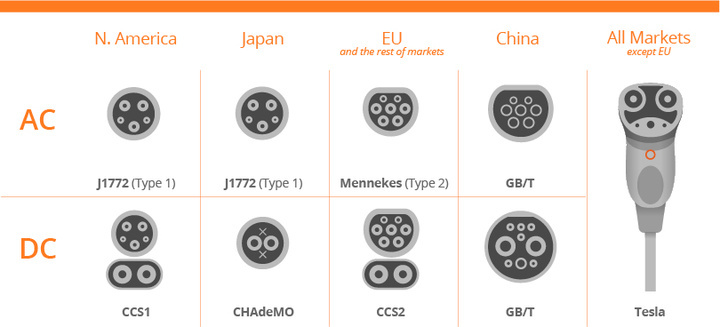
Charging connectors are the physical interfaces that allow electricity to flow from a charger into your EV. While charging levels define the speed and power, connector types determine compatibility between the charger and your vehicle.
Each charging level typically supports specific connectors, and it’s essential to understand which one your EV uses—especially when accessing public charging networks.
Level 1 and Level 2 Connectors: AC Charging
Both Level 1 and Level 2 chargers use alternating current (AC) and share the same connector type in North America:
| Connector | Used For | EV Compatibility | Notes |
|---|---|---|---|
| J1772 | Level 1 & 2 | All EVs (except Teslas without adapter) | North American AC charging standard |
| Tesla | Level 1 & 2 | Tesla vehicles only | Uses proprietary plug (can use J1772 with adapter) |
In Europe, the Type 2 Mennekes plug is standard for Level 2 AC charging.
Level 3 Connectors: DC Fast Charging
DC Fast Charging uses different connectors, depending on region and manufacturer. These are not interchangeable without adapters.
| Connector | Charging Level | Max Power Output | Compatible EVs | Notes |
|---|---|---|---|---|
| CCS (Combo 1) | Level 3 | Up to 350 kW | Most new EVs (Ford, VW, BMW, Hyundai, GM, etc.) | Becoming North America’s DC standard |
| CHAdeMO | Level 3 | Up to 62.5 kW | Older Nissan Leaf, Mitsubishi EVs | Being phased out |
| Tesla NACS | Level 3 | Up to 250 kW+ | Tesla, expanding to Ford, GM, Rivian (2025+) | Will likely become universal in U.S. |
Note: Many Tesla Superchargers are being equipped with CCS compatibility and NACS-to-CCS adapters to support other EVs.
Global Differences in Connectors
| Region | AC Connector (L1/L2) | DC Connector (L3) |
|---|---|---|
| North America | J1772, Tesla | CCS, CHAdeMO, Tesla NACS |
| Europe | Type 2 (Mennekes) | CCS2 (Combo 2) |
| Asia (Japan) | Type 1, CHAdeMO | CHAdeMO, CCS |
As of 2025, many automakers in North America are transitioning to the NACS (Tesla) connector, which simplifies access to Tesla’s Supercharger network and is becoming the dominant standard.
EV Types and Charging Compatibility
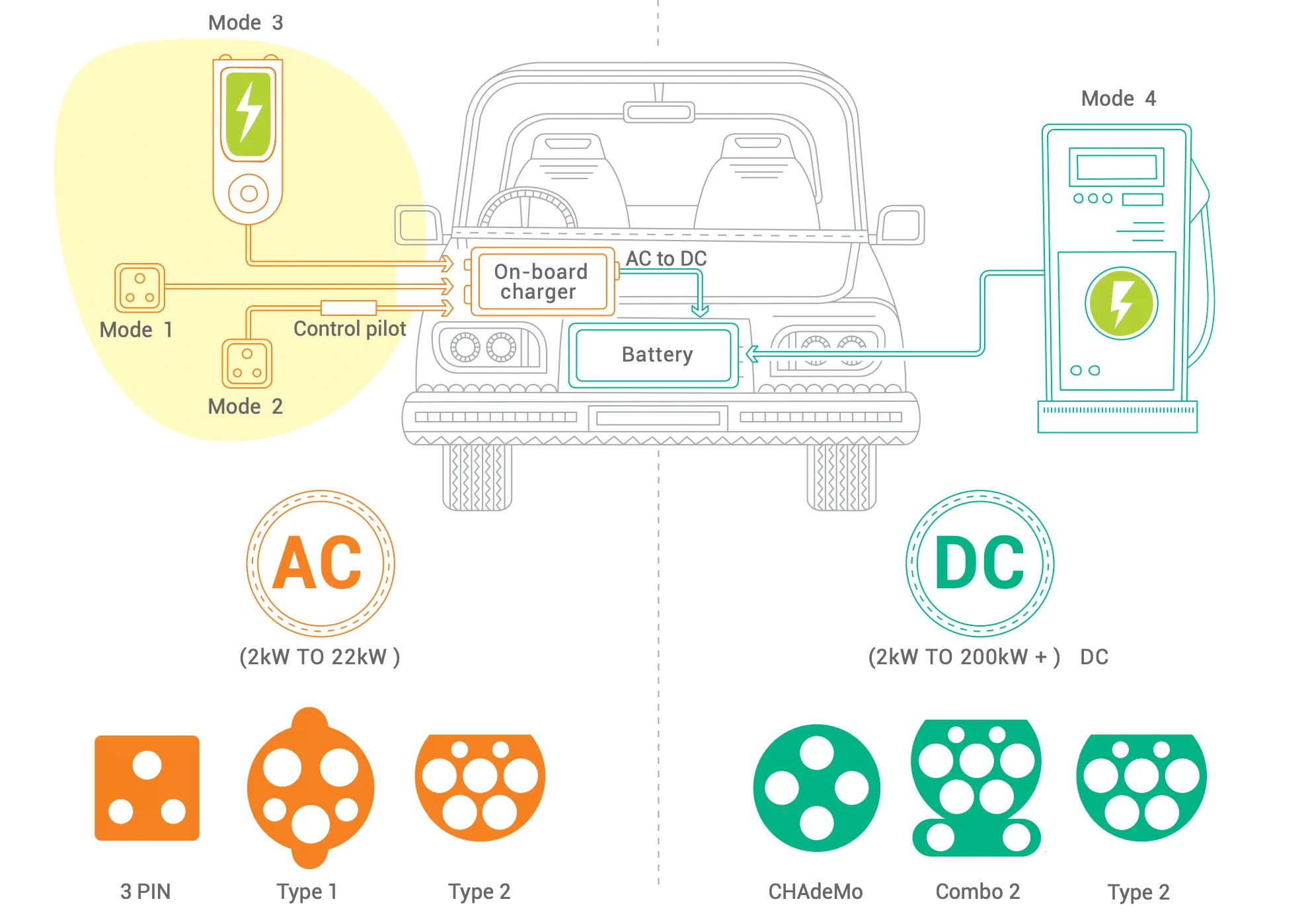
Not all electric vehicles are the same—and neither is their compatibility with different charging levels. The type of EV you drive greatly influences which charging levels and connectors are available to you, how fast your vehicle can charge, and what kind of infrastructure you need.
Below, we break down the major categories of EVs and how they interact with Level 1, Level 2, and Level 3 charging systems.
1. BEVs
Battery Electric Vehicles (BEVs) are fully electric vehicles with no internal combustion engine. They rely entirely on the battery for propulsion.
- Compatible with: Level 1, Level 2, and Level 3 (DC Fast Charging)
- Charging speed depends on:
- Battery size (e.g., 40–100+ kWh)
- Vehicle’s max AC/DC charge rate
- Examples: Tesla Model 3/Y, Chevy Bolt EUV, Hyundai Ioniq 5, Ford Mustang Mach-E
Best Charging Strategy: Use Level 2 for overnight charging; Level 3 for long-distance travel or quick top-ups.
2. PHEVs
Plug-in Hybrid Electric Vehicles (PHEVs) combine a small electric battery with a gasoline engine. They can drive short distances on electricity alone before switching to fuel.
- Compatible with: Level 1 and Level 2
- Not compatible with: Level 3 charging (in most cases)
- Examples: Toyota Prius Prime, Ford Escape PHEV, Honda Clarity PHEV
Best Charging Strategy: Level 1 is often sufficient overnight. Level 2 is useful for faster turnaround between short trips.
3. HEVs
Hybrid Electric Vehicles (HEVs) do not plug in and cannot use external chargers. Instead, they charge the battery internally using the engine and regenerative braking.
- Compatible with: None (no external charging)
- Examples: Toyota Camry Hybrid, Honda Accord Hybrid
Best Charging Strategy: N/A – These vehicles rely solely on internal charging systems.
4. FCEVs
Fuel Cell Electric Vehicles (FCEVs) use hydrogen fuel cells to generate electricity for the motor. While technically electric, they do not charge from the grid.
- Compatible with: None (no plug-in charging)
- Examples: Toyota Mirai, Hyundai Nexo
Best Charging Strategy: Refueled at hydrogen stations—not compatible with EV chargers.
EV Charging Compatibility Table
| Vehicle Type | Level 1 | Level 2 | Level 3 (DCFC) | Notes |
|---|---|---|---|---|
| BEV | Yes | Yes | Yes | Fully compatible across all levels |
| PHEV | Yes | Yes | Rarely | Some models may not support DCFC |
| HEV | No | No | No | No plug-in capability |
| FCEV | No | No | No | Refueled with hydrogen, not electricity |
Level 1 vs Level 2 vs Level 3: Full Comparison Table
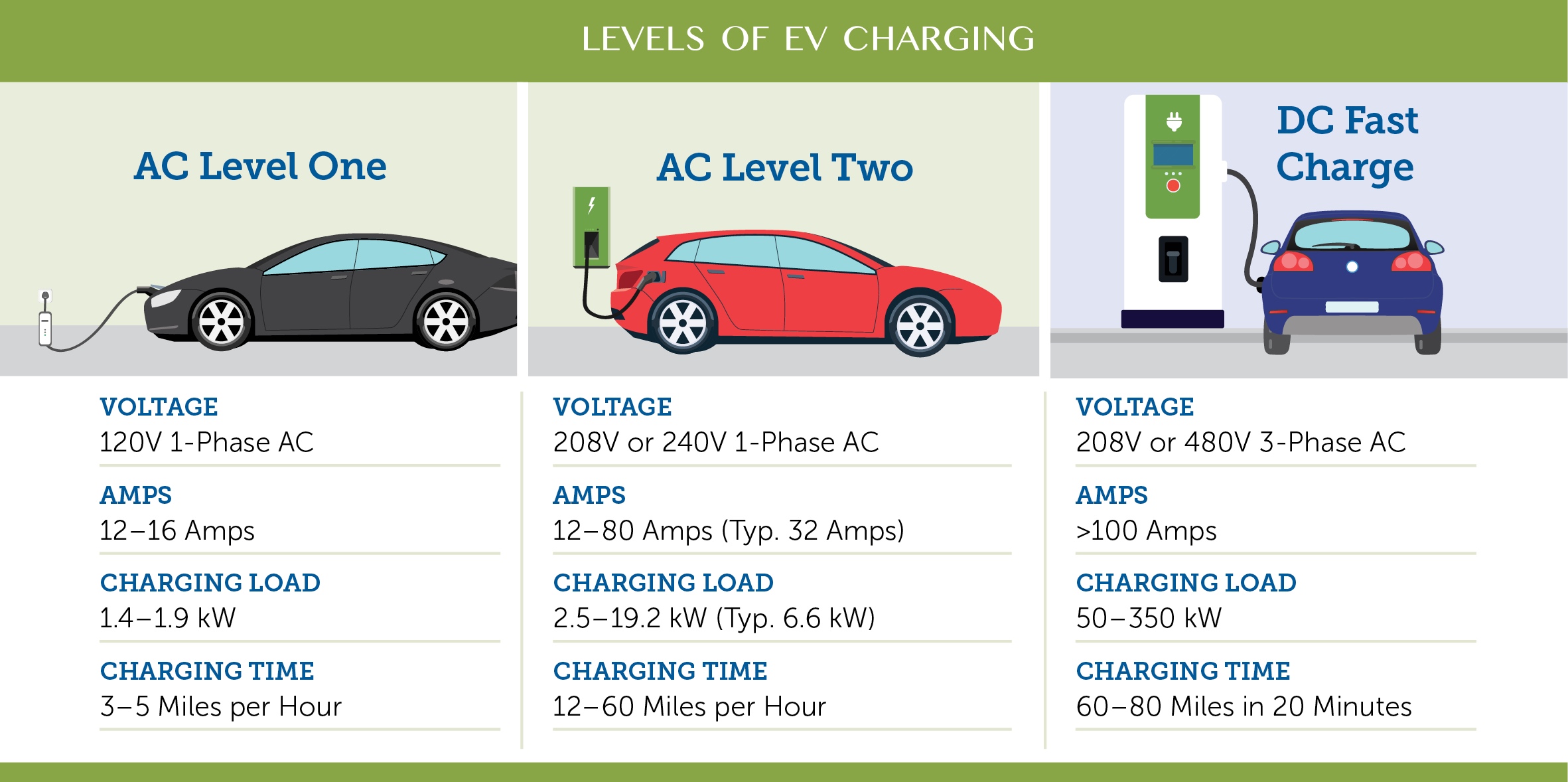
To help you clearly see the differences between each EV charging level, the table below compares voltage, charging speed, power output, installation requirements, and ideal use cases. This side-by-side view will help you determine which level best suits your needs.
| Feature | Level 1 Charging | Level 2 Charging | Level 3 Charging (DC Fast Charging) |
|---|---|---|---|
| Power Source | 120V AC (standard outlet) | 240V AC (dryer/electric range outlet) | 400V–1000V+ DC (commercial infrastructure) |
| Charging Speed | 2–5 miles of range per hour | 10–40 miles of range per hour | 100–1000+ miles of range per hour |
| Typical Use Case | Home charging for PHEVs or light EV use | Home/public charging for daily EV use | Public charging during travel or emergencies |
| Installation Required | No | Yes (licensed electrician recommended) | Yes (commercial-grade equipment only) |
| Charger Cost | Included with EV | $400–$1200 | $10,000+ (not for home use) |
| Installation Cost | None | $300–$1000+ | Varies (typically tens of thousands) |
| Time to Full Charge | 12–30+ hours | 4–10 hours | 15–40 minutes (to 80%) |
| EV Compatibility | All EVs | All EVs | BEVs only (most modern EVs) |
| Best For | Light daily driving, PHEVs | Daily use, commuters, home charging | Long-distance travel, commercial use |
| Battery Impact | Gentle | Balanced | Higher heat; may accelerate degradation |
Summary of Key Differences
- Speed: Level 3 is significantly faster, but only practical in public or fleet scenarios.
- Cost: Level 1 is nearly free, Level 2 has moderate setup costs, and Level 3 is costly and commercial-only.
- Accessibility: Level 1 and Level 2 are suitable for home; Level 3 requires industrial power.
The right charging level depends on your EV type, daily mileage, and whether you can charge at home or rely on public infrastructure.
How to Choose the Right EV Charging Level
Choosing the best EV charging level isn’t just about speed—it’s about matching the right charging strategy to your vehicle type, driving habits, living situation, and budget. Whether you’re charging at home, at work, or on the road, selecting the most efficient and cost-effective option can save you time, money, and energy.
1. Based on Your EV Type
| Vehicle Type | Recommended Charging Level |
|---|---|
| BEV (Battery Electric Vehicle) | Level 2 for daily use; Level 3 for road trips |
| PHEV (Plug-in Hybrid) | Level 1 may be sufficient; Level 2 if needed |
| HEV (Hybrid Electric) | Not applicable – cannot plug in |
| FCEV (Fuel Cell) | Not applicable – refueled with hydrogen |
Most BEV owners benefit most from a Level 2 charger at home, with Level 3 as a supplementary option for occasional fast charging.
2. Based on Your Daily Commute
| Daily Range | Ideal Charging Level |
|---|---|
| Under 40 miles | Level 1 or 2 (home charging) |
| 40–100 miles | Level 2 (home or public) |
| 100+ miles | Level 2 + occasional Level 3 |
If you drive long distances regularly and lack a home charger, you’ll likely rely on a combination of public Level 2 and Level 3 charging.
3. Based on Living Situation
| Living Environment | Best Charging Option |
|---|---|
| Detached Home | Install Level 2 at home |
| Apartment/Condo | Use public Level 2 or workplace |
| Urban Area | Level 3 charging hubs or shared Level 2 |
| Rural Area | Home Level 2 or mixed with Level 1 |
In multi-unit housing, shared Level 2 infrastructure or nearby public stations can serve as practical alternatives to private installation.
4. Based on Budget and Infrastructure
| Charging Level | Upfront Cost | Ongoing Cost (per kWh or session) | ROI Potential |
|---|---|---|---|
| Level 1 | $0–$50 | Very low | High (for PHEVs) |
| Level 2 | $700–$2,000 | Low | High (for daily BEV use) |
| Level 3 | N/A (commercial only) | High | Moderate (fleet or travel only) |
Level 2 home charging offers the best value over time, especially when factoring in convenience, utility savings, and battery health.
5. When to Use Each Level Strategically
- Level 1: As a backup, or for light use and plug-in hybrids
- Level 2: Your primary daily charging solution
- Level 3: On-demand fast charging for road trips, emergencies, or commercial fleets
Choosing a smart combination based on your unique lifestyle will ensure your EV ownership is efficient, cost-effective, and worry-free.
Conclusion
Understanding the differences between Level 1, Level 2, and Level 3 (DC Fast Charging) is essential to getting the most out of your EV ownership experience. Each charging level has a specific role, and knowing when and how to use each one can save you time, money, and unnecessary battery wear.
- Level 1 is perfect for plug-in hybrids or light daily use where overnight charging is sufficient.
- Level 2 is the most balanced and widely recommended option for daily EV charging—whether at home or in public.
- Level 3, or DC Fast Charging, offers unmatched speed for road trips or emergency top-ups but is best used sparingly due to higher cost and potential battery stress.
As EV technology continues to evolve, charging infrastructure is expanding, connector standards are consolidating, and access is becoming easier for more drivers. By selecting the right combination of charging levels based on your vehicle, lifestyle, and location, you’ll ensure your EV experience is efficient, sustainable, and future-ready.
FAQs: Common Questions About EV Charging Levels
Can I install a Level 3 charger at home?
No. Level 3 chargers require industrial-grade power infrastructure that far exceeds what’s available in residential settings. They use 400V to over 1000V and draw massive amounts of current—often 50 kW to 350+ kW—requiring special utility permissions and equipment.
For home use, Level 2 is the fastest and most practical option.
Will using Level 3 charging too often damage my EV battery?
Potentially, yes. Frequent use of DC Fast Charging can accelerate battery degradation over time, especially in older EVs or vehicles with smaller battery packs.
However, modern EVs are built with battery management systems (BMS) that regulate charging to minimize damage. Occasional use of Level 3 is safe, but Level 2 is better for daily charging.
Is Level 2 charging worth the installation cost?
Absolutely. If you drive a BEV and rely on your EV daily, installing a Level 2 charger at home can:
Fully charge your car overnight
Save time compared to Level 1
Reduce reliance on public infrastructure
Add value to your property
Many regions offer rebates, tax credits, or utility incentives to offset installation costs.
Can I charge any EV at any public charger?
Not always. While Level 1 and Level 2 AC chargers (J1772) are nearly universal, Level 3 DC Fast Chargers use different connector types:
CCS for most new EVs
NACS for Tesla (and many brands starting in 2025)
CHAdeMO for older Nissan and Mitsubishi models
Make sure your EV supports the connector type available—or use an adapter if your vehicle permits.
What’s the cheapest way to charge an EV?
Home charging using Level 2 during off-peak hours is usually the cheapest and most energy-efficient method. Some utility companies offer time-of-use (TOU) plans with reduced electricity rates at night or weekends.
Avoid relying on Level 3 public stations unless necessary—they typically charge higher per-kWh rates or session fees.

